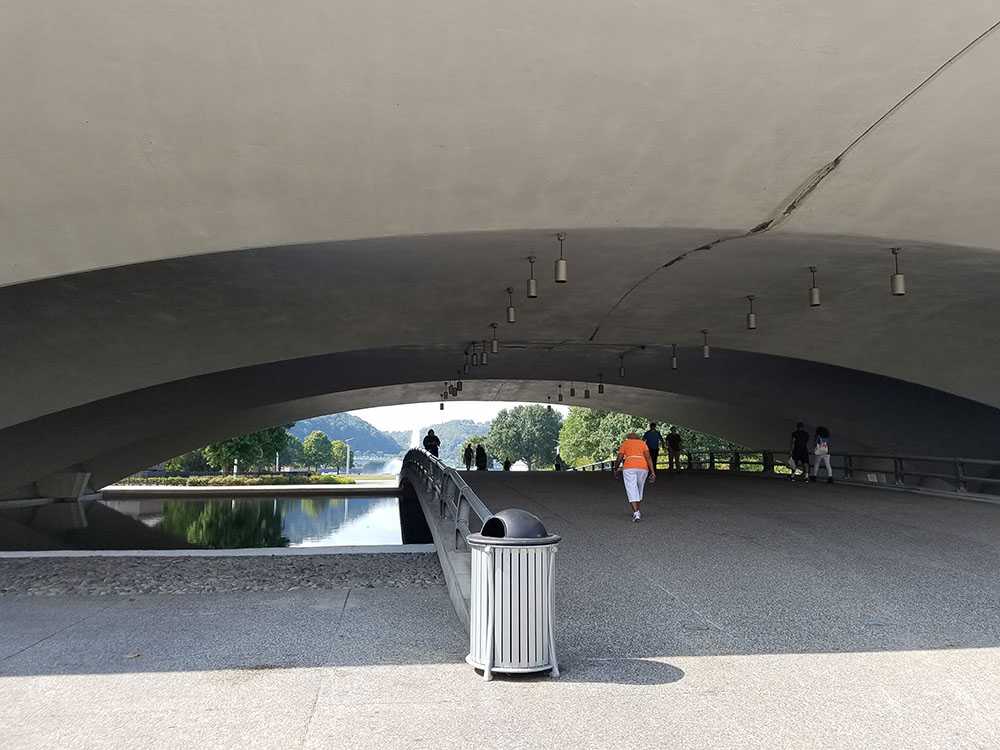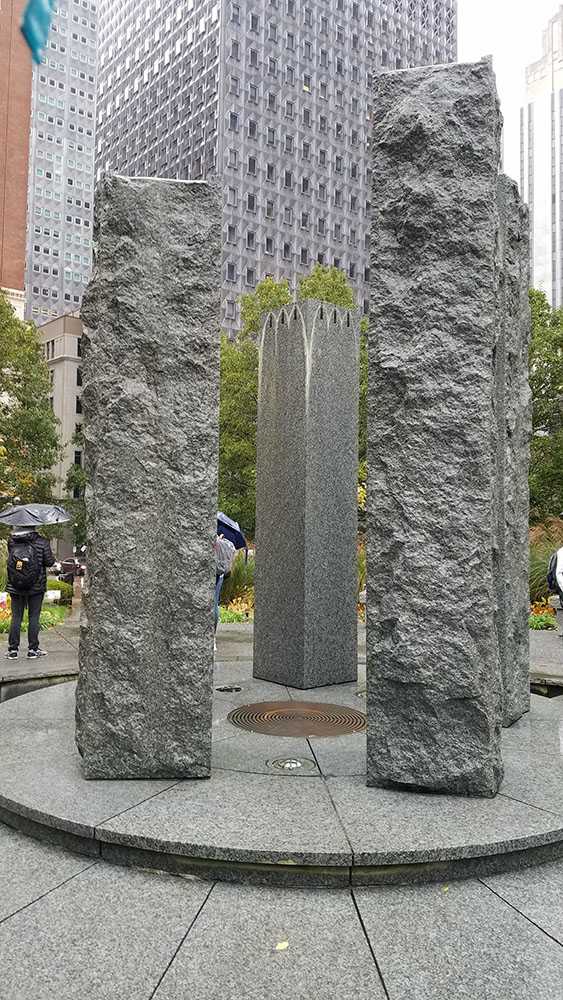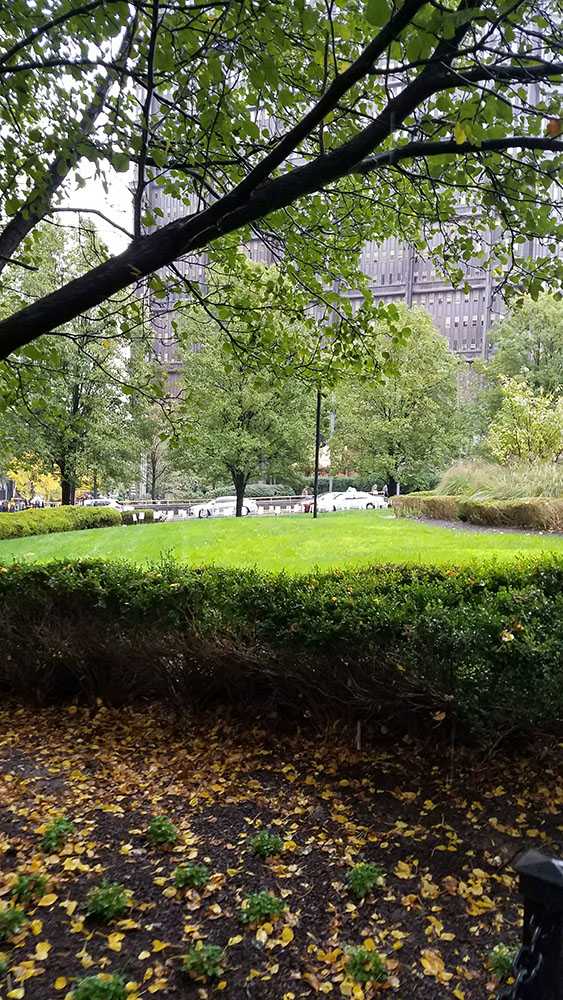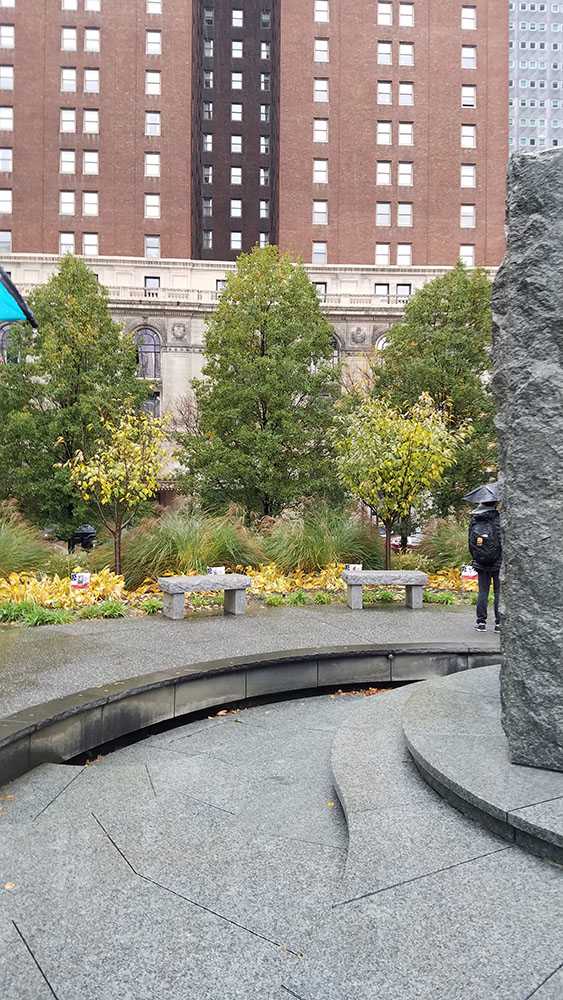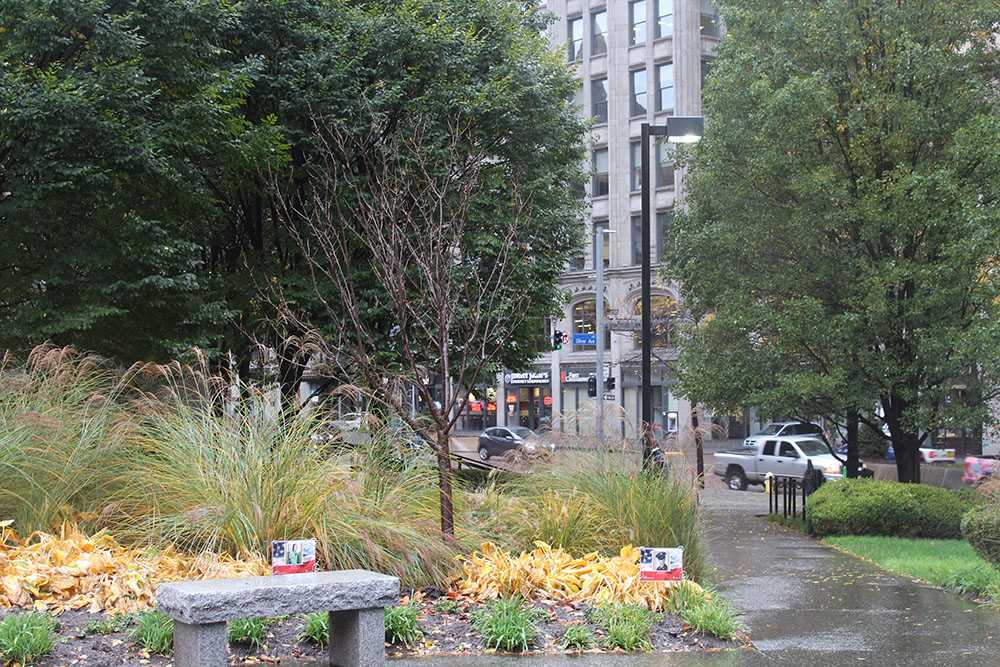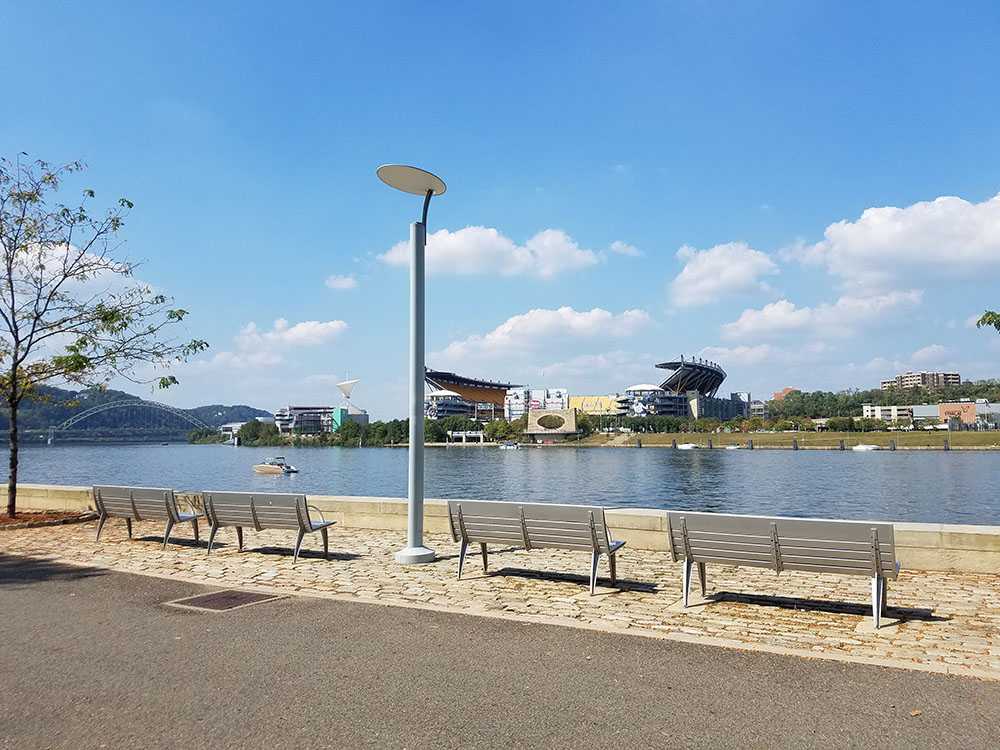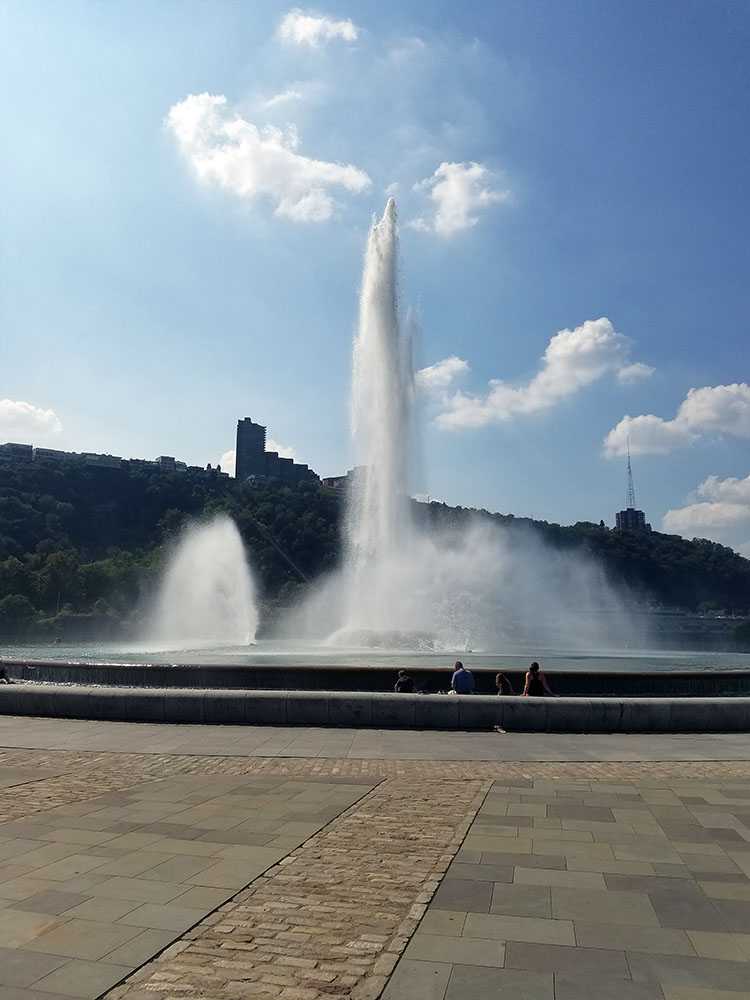Secret Pittsburgh
Reconnecting with Nature in Downtown Pittsburgh
By Elizabeth Madison
I feel the sunshine beating on my face. I feel the pleasant breeze brush my face (or in some cases the powerful gusts whack my face). I’m sitting on a bench looking out at the rivers flow, gazing at the beautiful hills on the other side. From this description, you may not guess that I am right next to downtown Pittsburgh, yet I am. I am at Point State Park, the Pittsburgh park built at the confluence of the Allegheny and Monongahela rivers that form the Ohio River. Not far away is another opportunity to enjoy being outside in the form of a smaller greenspace known as Mellon Green. One might be amazed at the number of greenspaces near Downtown Pittsburgh, but this notion of urban greenspaces has been gaining popularity in major cities across the United States and the world as people try to find ways of bringing back the importance of being connected to nature.
As kids, we seem to be encouraged to go outside and play, to take in the fresh air, to soak up the Vitamin D, to be connected with nature. However, as we grow older, the time and opportunity to be outside decreases until suddenly the only time spent outdoors is the time it takes to walk from our car to a nearby building. I often hear myself thinking, “What I wouldn’t give to be a kid again” when all the stress and worries of life seemed to be nonexistent and my day seemed to be filled with endless hours outside just enjoying the rejuvenated feeling of the fresh air that I didn’t seem to appreciate until now. The implementation of urban greenspaces seems to be an attempt to bring the peace and rejuvenating benefits of the outdoors back within the grasp of adults.
In a 2017 conference paper titled “Terminology of Urban Open and Green Spaces” from the ASEAN (Association of Southeast Asian Nations) Postgraduate Conference, urban greenspaces are defined as “all types of public or private open spaces in urban areas which is completely or mostly covered with vegetation” (Rakhshandehroo et al. 8). Research on urban greenspaces has indicated that urban greenspaces help increase physical activity and relaxation, filter out toxins in the air, and are important to mental health as they help to alleviate stress and anxiety (“Urban Green Spaces”). Many of the factors mentioned above are hard to come by in an urban area, especially a downtown center. Over the years, Pittsburgh has implemented several different types of urban greenspaces each with their own style, atmosphere, and target audience that help promote the increased exposure to nature and allow for time to get away from the hustle and bustle of life especially in a downtown area.
Mellon Green was opened in 1985 as part of a construction project that was also supposed to extend to include a major retail and office complex that never came to fruition (Hakimzadeh). As suggested by its name, Mellon Green was built and is owned by Mellon Financial. Surprisingly, despite being inside the frequently traveled Downtown Pittsburgh, Mellon Green has very little available information with almost all the information coming from either Wikipedia or the few newspaper articles covering the Occupy Pittsburgh movement. This reality leads to the space being able to be considered secret despite its location. If you happen to be downtown, it’s the greenspace surrounded by all the BNY Mellon buildings. Mellon Green is considered a privately-owned public space (P.O.P.S.) which is public space that is privately owned and must be open to the public in exchange for waivers (“New York City's Privately Owned Public Spaces.”). This came to become an issue during the Occupy Pittsburgh movement in 2011 in which peaceful protesters set tents on Mellon Green protesting against economic inequality and corporate corruption. Up to that point, Mellon Green consisted mainly of a flat lawn of grass with a fountain in the middle, which is why it was easy for the protestors to set up their tents. Even though Mellon Green was designated as a public plaza, BNY Mellon was able to gain a court order evicting the protesters who left peacefully on February 8, 2012 (Hakimzadeh). Once the protesters left, the topography of Mellon Green was made more uneven which would make it more difficult for tents to be put back up.
Today, if you visit Mellon Green you will see the large fountain in the middle of the space with a few benches surrounding it. The space is still broken up into sections of grass on each side of the four pathways that lead you to the fountain, but the uneven terrain of the grass makes is less likely for people to sit on in addition to the shrubbery in many of the sections that create a barrier between the people and the grass as seen in the second and third photos above. In terms of atmosphere, this space is targeted more towards business professionals in the area as an opportunity for them to get away from the office and just sit on one of the benches during their normal break or as a nice place to eat lunch. While at Mellon Green, I got the sense that this is not a space I would have played here as a child due to the space being small and the gates around certain areas as seen on the righthand side of the fourth photo above that make it look not as inviting for families. The gates, while being short and only connected together by loose chains at the top, still give off the warning “Don’t cross!” The limited amount of seating ensures that the space will not get crowded which would appeal to someone trying to get away from all the hustle and bustle associated with their work life. As a space surrounded by buildings, it provides workers with a little oasis during their day while still in close proximity to their job.
A different style greenspace built near Downtown Pittsburgh is Point State Park. Completed in 1974 after over a decade of planning and construction, Point State Park has become a multidimensional space used for a multitude of activities and personal uses. Here one can both participate in community events or in personal, solitary pursuits. Point State Park is quite larger than Mellon Green, and while many people do use the designated pathways, it is acceptable to walk right on the grass. During many of my visits to Point State Park, I have seen a mixture of people from families with their young children to business men and women simply sitting on one of the benches. Point State Park holds annual events such as the Three Rivers Regatta (an annual boat and river festival filled with music and other fun activities) and Light-Up Night (the annual event downtown opening the holiday season) which facilitate community and family-friendly activities that can be enjoyed outdoors. You can also pursue solitary interests such as a jogging near the river or just sitting at a nearby bench enjoying the views around you. One of my favorite things to do at the park is to sit at a bench on the side of the Allegheny River and just take in all the little details from the view in front of me. Robin Wall Kimmerer in the book Gathering Moss: A Natural and Cultural History of Mosses posits that seeing is more like listening than looking as one must look at the nuances of what one is seeing similar to the attentiveness one must have when listening to a conversation (11). The little details such as how the sunlight filters through the trees or a singular boat gliding across the river is always an aspect of my time at the park that I enjoy. No matter how many times I go I always notice something different which I believe enhances the experience.
Space theorist Edward Soja emphasizes in his theory of spatiality the importance of lived space – how people use a space and how it affects our lives (63-70). These urban greenspaces of downtown Pittsburgh, and in other downtowns around the world, demonstrate their importance through their lived space. Many of the personal views associated with a space come from the experiences I have had there such as enjoying a concert with my friend at Point State Park during Light-Up Night or laughing at myself trying to take pictures of Mellon Green in the rain. The significance of the space is quantified more by how we feel and the memories made in the space rather than only what we see in the space. Sometimes it may be a gloomy day outside or extremely cold, but as much as my face may hate me when the frigid wind is pounding my face, the rest of me feels at ease as if this moment of accepting the nature around me is what it needs to refresh itself. Somehow just the experience of being outside and inhaling the fresh air seems to mask all those negative perceptions away.
Whether it’s a large area like Point State Park or little niches like Mellon Green, urban greenspaces have found a way into our culture and provide a break from reality to enjoy the moment and just be. These spaces help bring the outside and nature-oriented experiences enjoyed in childhood into adulthood and ultimately remind me that it is okay and important to take time for oneself to rest.
Links for More Information:
Information on Point State Park:
Book on the planning and construction of Point State Park called The Shaping of the Point: Pittsburgh’s Renaissance Park by Robert C. Alberts: https://historicpittsburgh.org/islandora/object/pitt:31735057893343/from_search/ac5b3acc61f442fe3e57eada3065d368-0#page/1/mode/2up
Calendar of Point State Park Activities: https://events.dcnr.pa.gov/point_state_park#.XANBSNtKipq
Pennsylvania Recreation Guide for Point State Park (includes map): http://www.docs.dcnr.pa.gov/cs/groups/public/documents/document/dcnr_003295.pdf
Information on Mellon Green:
General Mellon Green: https://en.wikipedia.org/wiki/Mellon_Green
TripAdvisor Reviews on Mellon Green: https://www.tripadvisor.com/Attraction_Review-g53449-d6991691-Reviews-Mellon_Green-Pittsburgh_Pennsylvania.html
Works Cited:
Hakimzadeh, Sarah. "Mellon Green and Occupy Pittsburgh." Secrets of Pittsburgh, 9 Nov. 2018, Cathedral of Learning, Pittsburgh, PA. Lecture.
Kimmerer, Robin Wall. “Learning to See.” Gathering Moss: A Natural and Cultural History of Mosses. Oregon State University Press, 2003.
“New York City's Privately Owned Public Spaces.” NYC, Workers' Compensation Board, www1.nyc.gov/site/planning/plans/pops/pops.page. Accessed 30 Nov. 2018.
Rakhshandehroo, Mehdi & Afshin, Sahrakar & Mohd Yusof, Mohd Johari. “Terminology of Urban Open and Green Spaces.” 11th ASEAN Postgraduate Seminar 2017, 15 May 2017, University of Malaysia. ResearchGate, www.researchgate.net/publication/321300419_Terminology_of_Urban_Open_and_Green_Spaces, Accessed 30 Nov. 2018.
Soja, Edward. Thirdspace: Journeys to Lost Angeles and Other Real-and-Imagined Places. Blackwell Publishing Inc., 1996. 53-70.
“Urban Green Spaces.” World Health Organization, World Health Organization, 4 Aug. 2016, www.who.int/sustainable-development/cities/health-risks/urban-green-space/en/. Accessed 30 Nov. 2018.
